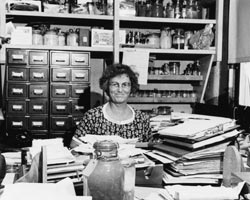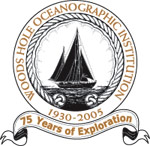This is an archived site. This site is no longer being maintained or reviewed for broken links.
Down to the Sea for Science—Mary Sears
 |
|
|
In this 1960 photo, Mary Sears is surrounded by papers and biological samples in her Bigelow Laboratory office. |
|
Mary Sears probably knew the Woods Hole Oceanographic Institution better than anyone else during the first half of its existence. As a Radcliffe College graduate student and assistant to Henry Bigelow at Harvard’s Museum of Comparative Zoology, her desk was near Bigelow’s while he was writing the National Academy report that resulted in the founding of WHOI. During Woods Hole summers in the 1930s, she worked both with him and on her own plankton projects, and he generally saw that she got to know the world’s leaders in marine science. She completed her Ph.D. in 1933, held the title of WHOI planktonologist beginning in 1940, and was named senior scientist in 1963 and scientist emeritus in 1978. In addition, she served tirelessly as clerk of the Corporation from 1947 to 1974.
Columbus Iselin observed that Mary Sears had “done as much for the advancement of oceanography as anyone I know.” As a WAVES (Women Accepted for Volunteer Emergency Services) officer from 1943 to 1946, she ran the Oceanographic Unit of the Navy’s Hydrographic Office, directing a staff of fifteen in the application of oceanography to war by assembling reports, charts, and pamphlets that served both Navy decision makers and operational units. She made her most enduring contribution to oceanography as editor of several journals and books, as well as many of the Institution’s annual reports and Collected Reprints volumes. She almost single-handedly organized the First International Congress on Oceanography held at the United Nations in 1959. Twenty years later, she co-edited Oceanography: The Past, the proceedings of the Third International Congress on the History of Oceanography held in Woods Hole in 1980 as part of WHOI’s fiftieth-anniversary celebration.
Because women were not permitted to go to sea until very late in her career, Sears’s only research voyages took place aboard Peruvian fishing vessels during studies of plankton and El Niño conditions for a guano company in Lima (and it was she, not the men aboard, who dove into the sea to retrieve a plankton net that had parted from the line!). Recognizing the results of this work, Director Smith wrote in the 1953 annual report that Sears was “well recognized as a marine biologist, and . . . now qualified as a significant contributor to general oceanography. It may be noted with regret that present conditions do not permit her to carry out her work at sea in person except through engagements with foreign agencies.” This was, of course, because there were no “proper facilities” for a lady. Sears later commented “But there were pails!” and maintained that, though there were no proper facilities on the Peruvian vessels, what made the difference was that there were proper gentlemen aboard. Despite the frustration of not being allowed to go to sea, Mary Sears made the best of her situation.
In 1963, she christened Atlantis II, a WHOI ship with “proper facilities,” and it was more than fitting that, in the year 2000, the U.S. Navy chose to name its sixth Pathfinder-class oceanographic survey ship USNS Mary Sears.

